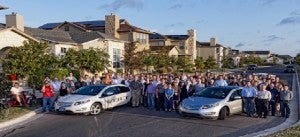Pecan Street’s Study Shows Electric Vehicles Won’t Overload the Electric Grid

Over the past few years, we’ve seen some of the world’s largest automakers release their first mass-market electric vehicles. Models like the Chevrolet Volt, Nissan Leaf and Tesla Model S are popular with consumers looking to reduce their carbon footprint and spend less at the pump. But the vehicles’ rising popularity has raised concerns about the effect they might have on the electric grid, particularly during the hot summer months in Texas.
Electric vehicles are the largest new home electric load in decades. Some suspected that drivers, upon returning home from work, would charge their vehicles during the evening hours (a ‘rush-hour’ time for the wires that carry our energy, which strains the electric grid). They thought that the increased need for energy would overwhelm the electric system, possibly force utilities to fire up more dirty fossil fuel power plants and offset any potential environmental benefits of the gasoline-free car. Thankfully, this line of thinking is now an idea of the past.
A recent report from Pecan Street proves that electric vehicles have less of an impact on the electric grid than anticipated.
Headquartered in Austin, Pecan Street Research Institute has developed the most “connected” network of energy customers in an effort to help utilities, consumer electronic companies and automakers design and test new energy-related products and services.
The data collected is used to understand exactly how new technologies affect the electricity system. In this instance, the team investigated how, exactly, a dense concentration of electric vehicles can impact the local electric grid.
 Based on the data collected from 31 Austin electric vehicle owners, researchers found that drivers don’t all plug in their vehicles simultaneously at 6 p.m., despite what many expected. Instead, electric vehicle charging is more spread out, peaking around 9 or 10 p.m. — after the 3–7 p.m. ‘rush-hour’ peak.
Based on the data collected from 31 Austin electric vehicle owners, researchers found that drivers don’t all plug in their vehicles simultaneously at 6 p.m., despite what many expected. Instead, electric vehicle charging is more spread out, peaking around 9 or 10 p.m. — after the 3–7 p.m. ‘rush-hour’ peak.
It is important to note that Pecan Street’s report reflects behavior from a neighborhood with the highest concentration of electric vehicles in the U.S. Whereas, most U.S. electric utilities serve neighborhoods with far fewer electric vehicle owners, supporting the view that EVs won’t overwhelm the electric system.
In fact, electric vehicles could actually provide a benefit to electric utilities – especially in Texas. According to the report, most charging occurs at night, when West Texas wind is plentiful and electricity prices are at their lowest. Utilities benefit from selling inexpensive wind power to customers at night, and we all benefit from replacing gasoline with cleaner electricity from the grid. Furthermore, if potential charging problems do occur, utilities can incentive customers to shift their energy use to take advantage of inexpensive wind power.
Pecan Street’s study shows us that technologies, like electric vehicles, may be new but that doesn’t mean they will bring down the electric grid. More than anything, the report underscores the importance of a smart, flexible, resilient grid.
Understanding exactly how much power is flowing in real time allows for more customer-facing, demand-side resources, such as rooftop solar panels, greater use of modern, clean energy technologies and the ability to foresee and correct problems that could result in power failures and brownouts. A smart grid is the key to unlocking a clean grid.











2 Comments
I set my car to start charging at 10:30 p.m. I don’t have a financial incentive to do so, but it just makes sense.